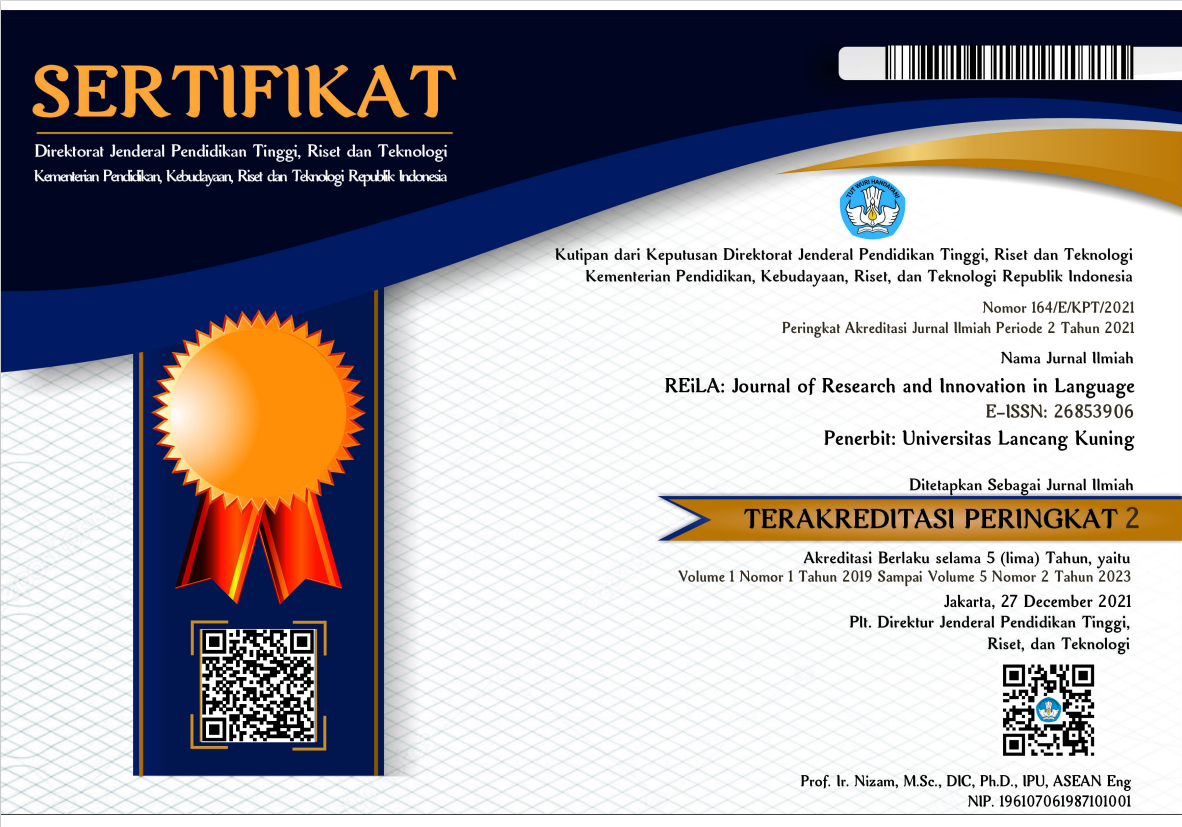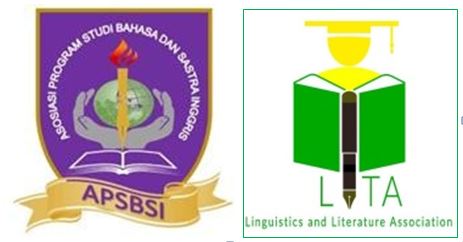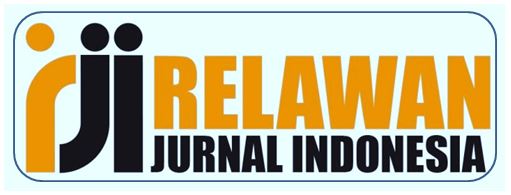Exploring the Language Usage in Mark Twain’s Novel “Adventures of Tom Sawyer”: Hegemonic Masculinity Analysis
Abstract
The practice of legitimizing men’s dominance is known as hegemonic masculinity, and it is a concept that has often been explored through numerous adult novels, but rarely in children’s literature. To address this research gap, this study conducted a text analysis on the types of hegemonic masculinity depictions in Mark Twain’s “Adventures of Tom Sawyer”, as one of the most read novels by young readers who attend schools with an international curriculum. The researchers used the descriptive qualitative method hand in hand with Connell and Messerschmidt’s theory of hegemonic masculinity. The result showed 3 types of hegemonic masculinity displayed in the novel include toxic masculinity, bad boy archetype, and dominant-submissive roles. These types can influence young to imitate bad role model, engage in bullying, and develop an unhealthy habit of hiding their feelings. Young readers may begin to see mischievous, manipulating, and aggressive behaviour as a common thing to do or even should be done to establish their place in society. Tom Sawyer is mandatory reading in the curriculum and is a classic that is unlikely to be taken off of the syllabus, so this study recommends teachers to make students become aware of the underlying ideas and values implicated in the novels. This study presented the implication for schools which assigned the reading of “Tom Sawyer” to address the reality of hegemonic masculinity in the novel to reduce the possible effect of its themes.
Downloads
References
Ahmed, A. (2017). Literature and its influence on human life. http://data. conferenceworld. in/NCCW/P129-134. pdf.
Aldana-Bobadilla, E., Molina-Villegas, A., Montelongo-Padilla, Y., Lopez-Arevalo, I., & S. Sordia, O. (2021). A language model for misogyny detection in Latin American Spanish driven by multisource feature extraction and transformers. Applied Sciences, 11(21), 10467.
Alsyouf, A. (2018). Hegemonic masculinity in archetypal African novels. INFORMASI: Kajian Ilmu Komunikasi, 48(2), 169-179. https://doi.org/10.21831/informasi.v48i2.21657
Anzovino, M., Fersini, E., & Rosso, P. (2018, June). Automatic identification and classification of misogynistic language on twitter. In International Conference on Applications of Natural Language to Information Systems (pp. 57-64). Springer, Cham.
Archer, J. (2004, December). Sex differences in aggression in real-world settings: A meta-analytic review. Review of General Psychology. 8(4), 291-322. https://doi.org/10.1037/1089-2680.8.4.291
Aulette, J., & Connell, R. W. (1991). Gender and power: Society, the person and sexual politics. Social Forces, 69(3), 953. https://doi.org/10.2307/2579508
Bauer, N. M., & Santia, M. (2021). Going feminine: Identifying how and when female candidates emphasize feminine and masculine traits on the campaign trail. Political Research Quarterly, 6. 1-15. https://doi.org/10659129211020257.
Bauman, A. E., Reis, R. S., Sallis, J. F., Wells, J. C., Loos, R. J., Martin, B. W., & Lancet. (2012). Physical activity series working group correlates of physical activity: Why are some people physically active and others not? The Lancet, 380, 258-271. https://doi.org/10.1016/S0140-6736(12)60735-1
Bertrand, M., Black, S. E., Jensen, S., & Lleras-Muney, A. (2019). Breaking the glass ceiling? The effect of board quotas on female labour market outcomes in Norway. The Review of Economic Studies, 86(1), 191-239.
Black, A., Joan, S. S., & clearly love Sacramento, Y. (2022). Quixotic pedagogy and attention in the early modern literature classroom. Feminist formalism and early modern women's writing: Readings, conversations, Pedagogies
Boord, M. (2021). Fatherhood in labour zionist children’s literature: space, masculinity and hegemony in mandate palestine. Gender and History. 0(0), 1-15. https://doi.org/10.1111/1468-0424.12561
Brody, D. L. (2015). The construction of masculine identity among men who work with young children, an international perspective. European Early Childhood Education Research Journal, 23(3), 351-361. https://doi.org/10.1080/1350293X.2015.1043809
Campos, F., Goldstein, M., McGorman, L., Munoz Boudet, A. M., & Pimhidzai, O. (2015). Breaking the metal ceiling: female entrepreneurs who succeed in male-dominated sectors. World Bank Policy Research Working Paper, (7503). https://ssrn.com/abstract=2698440
Casad, B. J., Franks, J. E., Garasky, C. E., Kittleman, M. M., Roesler, A. C., Hall, D. Y., & Petzel, Z. W. (2021). Gender inequality in academia: Problems and solutions for women faculty in STEM. Journal of neuroscience research, 99(1), 13-23. https://doi.org/10.1002/jnr.24631
Castillo, D. A. (2016). The bad boy antihero and contemporary politics: Scarface and Gunday. Humanities Commons. 1-9. https://doi.org/10.17613/M6CS40
Common Core State Standard Initiative. (n.d.). Texts illustrating the complexity, quality, & range of student reading 6-12. Common Core. http://www.corestandards.org/ELA-Literacy/standard-10-range-quality-complexity/texts-illustrating-the-complexity-quality-range-of-student-reading-6-12/
Connell, R. W., & Messerschmidt, J. W. (2005). Hegemonic masculinity: Rethinking the concept. Gender & society, 19(6), 829-859.https://doi.org/10.1177/0891243205278639
Donaldson, M. (1993). What is hegemonic masculinity? Theory and Society, 22(5), 643–657. https://doi.org/10.1007/BF00993540
Dugan, E., & Umachandran, M. (2021). 10 Racing and gendering classical mythology in the incarcerated classroom. Classics and Prison Education in the US. 1st Edition, Routledge
Evans. G. L. (2018). Men and masculinities in the sagas of Icelanders. Oxford Scholarship Online.
Fancher, P., & Whittet, E. O. C. (2018). Misogyny in the classroom: Two women lecturer's experiences. Composition Studies, 46(2), 192-238.
Farrell, T., Fernandez, M., Novotny, J., & Alani, H. (2019, June). Exploring misogyny across the manosphere in reddit. In Proceedings of the 10th ACM Conference on Web Science (pp. 87-96). https://dl.acm.org/doi/abs/10.1145/3292522.3326045
Garrison, K., Mary, M., & Derouet, E. (2021). Of men and masculinity: The portrayal of masculinity in a selection of award-winning Australian young adult literature. Knygotyra, 76, 228-259. https://doi.org/10.15388/Knygotyra.2021.76.82
Garvey, C. (1977). Play with language and speech. Child Discourse, 27–47. https://doi.org/10.1016/B978-0-12-241950-8.50008-3
Geva, D. (2020). A double-headed hydra: Marine Le Pen’s charisma, between political masculinity and political femininity. NORMA, 15(1), 26-42.
Gopaldas, A., & Molander, S. (2020). The bad boy archetype as a morally ambiguous complex of juvenile masculinities: the conceptual anatomy of a marketplace icon. Consumption Markets & Culture, 23(1), 81-93. https://doi.org/10.1080/10253866.2019.1568998
Guanio-Uluru, L. Female Focalizers and masculine ideals: gender as performance in twilight and the hunger games. Child Lit Educ 47, 209–224 (2016). https://doi.org/10.1007/s10583-015-9263-1
Hamuddin, B., Rahman, F., Pammu, A., Baso, Y. S., & Derin, T. (2020). Cyberbullying among efl students' blogging activities: Motives and proposed solutions. Teaching English with Technology, 20(2), 3-20. https://www.ceeol.com/search/article-detail?id=850506
Hastinqs, R. P., & Brown, T. (2002). Behavior problems of children with autism, parental self-efficacy, and mental health. American Journal on Mental Retardation, 107(3). https://doi.org/10.1352/0895-8017(2002)107<0222:BPOCWA>2.0.CO;2
Hinojosa, R. (2010). Doing hegemony: Military, men, and constructing a hegemonic masculinity. The Journal of Men’s Studies, 18(2), 179–194. https://doi.org/10.3149/jms.1802.179
Huang, J., Gates, A. J., Sinatra, R., & Barabási, A. L. (2020). Historical comparison of gender inequality in scientific careers across countries and disciplines. Proceedings of the National Academy of Sciences, 117(9), 4609-4616. https://doi.org/10.1073/pnas.1914221117
Kray, L. J., & Haselhuhn, M. P. (2012). Male pragmatism in negotiators’ ethical reasoning. Journal of Experimental Social Psychology, 48(5), 1124–1131. https://doi.org/10.1016/j.jesp.2012.04.006
Kristal, T., & Yaish, M. (2020). Does the coronavirus pandemic level the gender inequality curve?(It doesn’t). Research in Social Stratification and Mobility, 68, 100520. https://doi.org/10.1016/j.rssm.2020.100520
Lynn, T., Endo, P. T., Rosati, P., Silva, I., Santos, G. L., & Ging, D. (2019, June). A comparison of machine learning approaches for detecting misogynistic speech in urban dictionary. In 2019 International Conference on Cyber Situational Awareness, Data Analytics And Assessment (Cyber SA) (pp. 1-8). IEEE.
Miehls, D. (2017). Hegemonic views of masculinity and bullying: Clinical work with men who were bullied as children. Clinical Social Work Journal, 45(1), 56-64. https://doi.org/10.1007/s10615-016-0581-6
Mishra, I. A. (2020). Exploration of masculinity in Sanjeev Upreti’s Hansa. JODEM: Journal of Language and Literature, 11(1), 44–59. https://doi.org/10.3126/jodem.v11i1.34805
O’Connor, T. (2015). Men choosing nursing: Negotiating a masculine identity in a feminine world. The Journal of Men’s Studies, 23(2), 194-211. https://doi.org/10.1177/1060826515582519
Plaza-Del-Arco, F. M., Molina-González, M. D., Ureña-López, L. A., & Martín-Valdivia, M. T. (2020). Detecting misogyny and xenophobia in Spanish tweets using language technologies. ACM Transactions on Internet Technology (TOIT), 20(2), 1-19.
Pörhölä, M., Cvancara, K., Kaal, E., Kunttu, K., Tampere, K., & Torres, M. B. (2020). Bullying in university between peers and by personnel: cultural variation in prevalence, forms, and gender differences in four countries. Social Psychology of Education, 23(1), 143-169.
Pruitt, C. (2019). “Boys ‘Round Here”: Masculine life-course narratives in contemporary country music. Social Sciences, 8(6), 176-194. https://doi.org/10.3390/socsci8060176
Qin, K. (2019). Performing curriculum and constructing identity: Small stories as a framework for studying identity and learning in classroom discourse. International Multilingual Research Journal, 13(3), 181-195. https://doi.org/10.1080/19313152.2019.1623638
Ratna, N. K. (2010). Sastra dan cultural studies: Representasi fiksi dan fakta. Pustaka Pelajar, (1871), 5–7.
Roberson, S. (2020). From small beginnings to large-scale harm: On demagoguery and misogyny in the classroom and writing center. [Thesis, Virginia Commonwealth University]. VCU scholar Compass. https://scholarscompass.vcu.edu/etd/6278/.
Simonsson, A. (2020). Smooth conversations: sexuality as a linguistic resource in a secondary language classroom. Discourse: Studies in the Cultural Politics of Education, 41(1), 21-31. https://doi.org/10.1080/01596306.2018.1481825
Smith, P. K., López-Castro, L., Robinson, S., & Görzig, A. (2019). Consistency of gender differences in bullying in cross-cultural surveys. Aggression and violent behavior, 45, 33-40.
Subrayan, A., & Roselezam Wan Yahya, W. (2016). Complicity to hegemonic masculinity in D.H. Lawrence’s sons and lovers. International Journal of Comparative Literature and Translation Studies, 4(2), 33-37.
Triati, Mentari; Sukirno; Setyorini, N. (2014). Analisis aspek sosiologi sastra naskah jin abg karya anes prabu sadjarwo dan rencana pelaksanaan pembelajaran di SMA. Surya Bahtera, 5(45), 195–200.
Yang, Y. (2020). What’s Hegemonic about hegemonic masculinity? legitimation and beyond. Sociological Theory, 38(4), 318–333. https://doi.org/10.1177/0735275120960792










